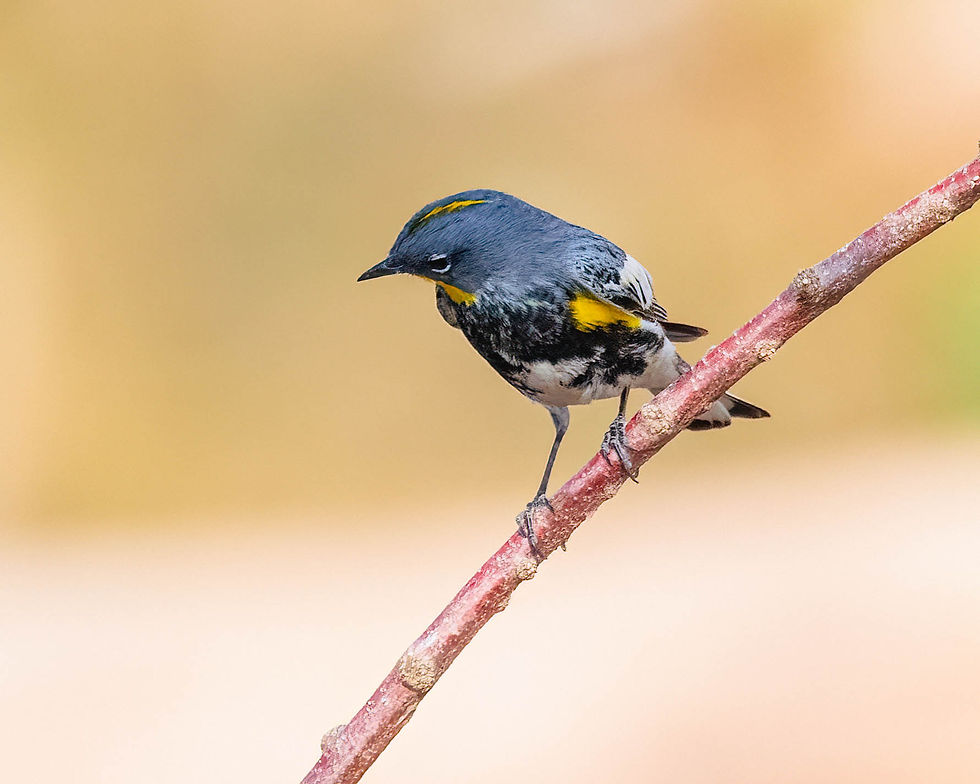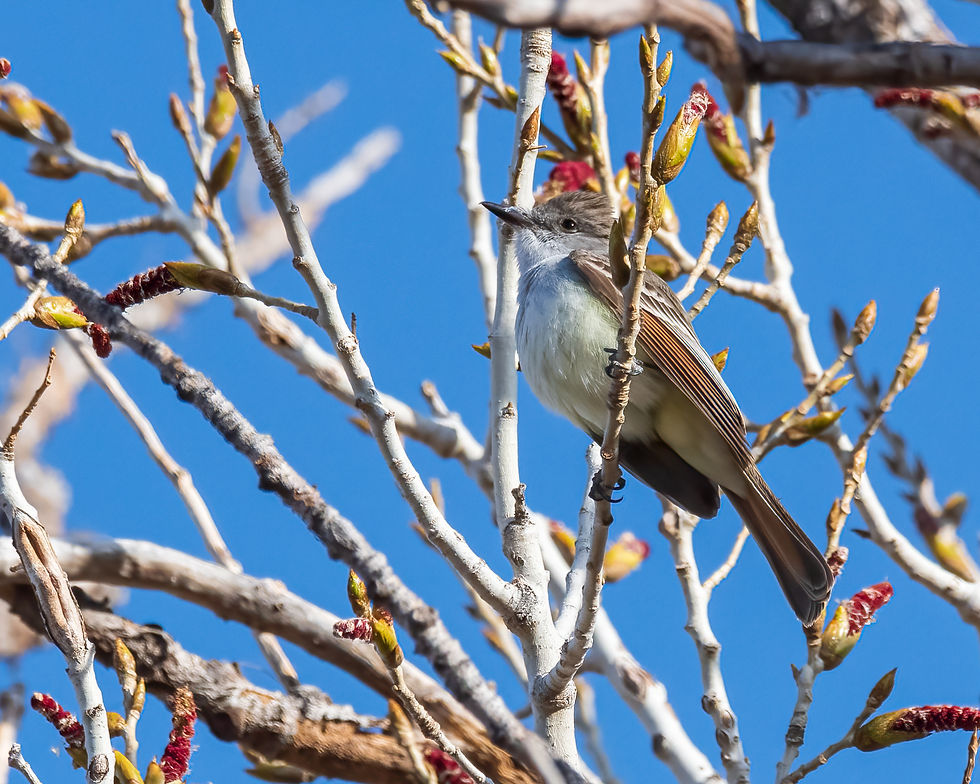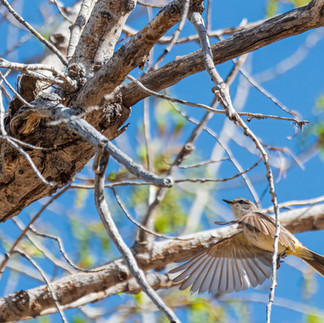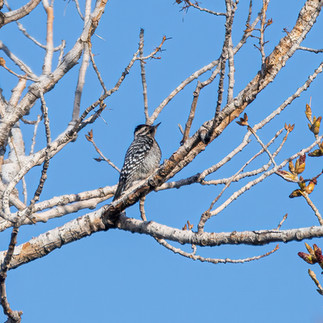Spring Migration at Palo Duro Canyon
- Vicki Wilmarth
- Apr 25, 2022
- 3 min read

After a long winter and an extremely slow start, spring migration is finally bustling at Palo Duro Canyon State Park. While the traditional birding guides calculate that flycatchers and warblers will begin showing up in mid-March, few reports of any interesting migrants in 2022 occurred before mid-April. But at Palo Duro Canyon, it was worth the wait.
The big news for local birders this spring is that a pair of Vermilion Flycatchers has decided to build a nest in Hackberry Campground near campsite #9. These stunning red birds (at least, the male is stunning and red), are rare visitors to our area. They prefer Mexico and far south Texas. Kenneth Seyffert recorded less than a half-dozen Vermilion Flycatcher nests in the Texas Panhandle in the last half of the 20th century in his 2001 book, Birds of the Texas Panhandle. But in 2022, a pair has decided to see if Palo Duro Canyon is a hospitable nursery for some baby flycatchers.
According to Cornell University's excellent online resource, Birdsoftheworld.org (a subscription service), once the female flycatcher finishes building the small nest, she will incubate eggs for about two weeks. Pretty Boy will bring her food while she is on the nest. Only a couple of weeks after hatching, the young flycatchers will be ready to leave the nest. So the month of May 2022 should afford birdwatchers many opportunities to watch the family's activities (from a respectful distance, of course, so as not to disturb the birds during this exciting event).
The Vermilion Flycatchers aren't the only interesting spring migrants in the "Jewel of the Texas State Park System." Palo Duro Canyon's cottonwoods and willow trees produce catkins (slim, cylindrical flower clusters) in the spring that are magnets for warblers. I have found on cool spring mornings that if I stop and quietly scan the tree tops along the creek in Hackberry Campground or Soapberry Day Use area, I can usually see warblers rapidly hopping around and feeding on the bugs and worms hiding in these catkins.

While Yellow-Rumped Warblers and Orange-Crowned Warblers are frequent spring visitors and easy to spot during every migration, Peggy Trosper and I were fortunate enough to see some much rarer warblers, two Nothern Parulas, at the state park on April 23, 2022. These tiny warblers generally stay in the eastern half of the United States. We are 100's of miles away from the western edge of their usual stomping grounds. So it is a thrill to spot them in our area.
Wilson's Warblers are not rare in our area, but they are fun to find because their bright yellow/olive coloring and black cap stand out in the dull vegetation in the canyon. Like all warblers, they move so rapidly that I often just see a blur of yellow out of the corner of my eye. But occasionally, a Wilson's Warbler will pose for me.
Broad-winged Hawks are also unusual visitors in our area and I've never spotted one in Palo Duro Canyon before (although I've seen them in my suburban Amarillo neighborhood several times). Like the Northern Parulas, these little buteos tend to spend more time in the Eastern United States. But on a Saturday in mid-April 2022, this young hawk was perched along the Paseo del Rio trail at the state park, giving me the side-eye and looking kind of cold.

Spring in the canyon also brings the return of many favorite birds that will summer in our area. Blue-gray Gnatcatchers have started buzzing in the hackberry trees, flycatchers like Ash-throated Flycatchers and Eastern Phoebes are already dive-bombing the bugs that are hatching along the trails, Bullock's Orioles are starting to sing in the treetops, and Barn Swallows are building their nests in the outdoor amphitheater where the musical Texas will be performed all summer.





The one summer visitor that I have not seen at the canyon in April 2022 is the most highly-anticipated summer resident of Palo Duro Canyon. I'm hoping that by May 1, the Painted Buntings will have returned.

While I wait for the showy Painted Buntings to appear, there are also many interesting year-round residents of Palo Duro Canyon to be spotted if I look closely while I am hiking at the canyon. Deer, Nothern Cardinals, Black-Crested Titmouse, Ladderback Woodpeckers, Cottontails, Wild Turkey, Red-tailed Hawks, Porcupines, Canyon Towhees, Golden-Fronted Woodpeckers, Turkey Vultures and Rock Wrens are always present at the vast state park.
Spending a couple of hours on a spring morning in Palo Duro Canyon is a balm to my winter-weary soul. I am so grateful to be able to observe and photograph the wonderful wildlife that abounds in the state park.























































Hello Vicki,
Greg Lusk, ED and horticulturist at Amarillo Botanical Gardens here. I am installing a Bird Garden here at the Gardens and need some direction please. The garden will be planted with plants utilized by birds for food, cover or nesting. It will be very educational with good quality signage for our 80,000 to 100,000 yearly visitors. Many are school children on school field trips. I need a list of about 12 birds that can be found in Amarillo in our gardens. Bird that spend most of the year here and are likely to nest here or are interesting or in particular need of conservation and attention. Can you help me with this? If you have a lar…